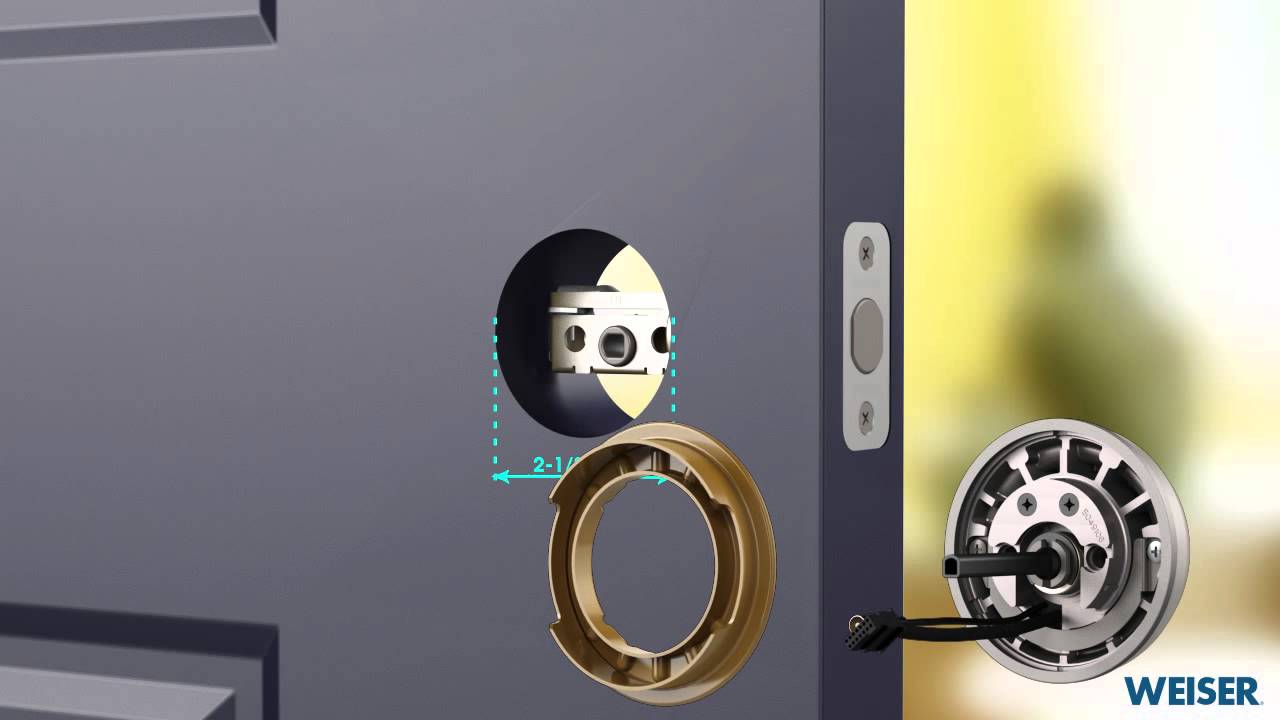 Your front door is a pretty important part of your home. Separating you from the outside, intruders and more, the front door is the friend you forget as you bang it, kick it and shove it walking into your house. Be a bit nicer to your front door this summer. In this edition of the Connected Home series, I’m going to discuss upgrading your deadbolt to a keyless entry system. It’s a little more expensive than just replacing a manual lock, but it takes about as much time and you get to reap the rewards of the ease and convenience you get.
Your front door is a pretty important part of your home. Separating you from the outside, intruders and more, the front door is the friend you forget as you bang it, kick it and shove it walking into your house. Be a bit nicer to your front door this summer. In this edition of the Connected Home series, I’m going to discuss upgrading your deadbolt to a keyless entry system. It’s a little more expensive than just replacing a manual lock, but it takes about as much time and you get to reap the rewards of the ease and convenience you get.
Why get keyless entry for your home?
Keyless entry into your home isn’t necessarily a new concept. It’s been around in some form for over 20 years. You can still get the original form (keypad passwords) at many hardware stores. However, the smartphone friendly equivalent hasn’t been around for more than a couple of years. If you’re on the fence, consider some of the benefits you can get from smarthome keyless entry into your home:
- The need for physical house keys can be made obsolete. While you’ll still have the ability to go in and out with keys, they’re not always necessary. This is a great alternative for large families that might not want 6 or 7 house keys floating around.
- You have better control of who has access in and out of your house. You won’t have to give a permanent house key to the cleaning lady or any contractors coming in and out of the house. You can set them up with expiring electronic keys that can use with their phone.
- It’s easy to install. I have the handyman skills of a wet sack of grapes, yet I was able to successfully install 3 different keyless entry systems in my home very easily.
One thing to keep in mind through all of this is that these products are merely replacing one entity of your entry into the home. If you’re replacing older technology or locks, you may want to consider upgrading things like your strike plates or door chains as well. You should also make concessions for noise. Since all of these devices are running off internal motors, expect a fair bit of noise during operation.
What are my options?
One benefit to what’s out there right now is that there isn’t much. Whether it’s based on difficulty to create or the end cost (Keyless entry is on average the most expensive single smarthome device out there,) you don’t have many manufacturers to lean on. Why is that beneficial to you? The absence of abundant options actually means that your choices are easy to make. In fact, in this blog, I’m basically going to narrow it down to two options, both of which are available at Best Buy right now. Let’s take a look at them.

The Weiser Kevo was the first mass marketed smartphone keyless entry system in Canada. With the touch of your finger to the outer deadbolt, Kevo connects to your phone via Bluetooth and authenticates your proximity to lock or unlock the door. If you don’t have a supported smartphone, backup is available in the way of a key-sized fob or standard keys (it comes with a small set.)
Why get a Kevo?

The Kevo has a fairly easy and intuitive setup process. All you need is a Phillips Head Screwdriver and about 20-30 minutes. The touch piece is very sensitive as well. It’s touch-sensitive and doesn’t have any sort of fingerprint sensor, so if your hands are full, you could brush your elbow or forearm to begin the authentication process.
The whole system runs off Bluetooth authentication and not your internet connection. In fact, when we had network issues and I had to go around the house setting up my smarthome devices again, the Kevo was the only one I didn’t have to do anything with.
Battery life is also great. The system runs continuously on 4 AA batteries and say they will last approximately a year. I managed to get about 15 months out of my initial setup before I had to replace batteries.
Why not to get a Kevo?
There are two convenience based matters that may affect your decision to purchase a Weiser Kevo. The first is the fact that you’re replacing your entire deadbolt system, which means that you’re replacing the key too. This means that if you can’t get software support and run out of fobs, you’re carrying a new key. Having a locksmith set the lock to be the same as your other locks will be a difficult task I would imagine, since it appears that everything is interconnected electronically (and the lock mechanisms are hidden behind the electronics.)
The second consideration is the actual software support which I just eluded to. Since Kevo is a bluetooth product, Weiser has faced some difficulty with Android integration. An android app IS available, but it requires fairly newer Android OS software and if you have an older phone, you’re probably out of luck and will have to use a fob instead.
If you’re interested in reading more about the Weiser Kevo, please click here to read my review of the device as well as watch an installation video.

August is a newcomer in the smarthome doorway entry market having only been in Canada for a couple of months. I was initially worried about installing it when I started reading about how fragile the installation process was, but I didn’t find that to be an issue at all. In fact, you would have to go against the directions and almost out of your way altogether to try to break it.
Why get an August Lock?

Quite simply put – Ease. Everything about the August Lock is easy. The directions are laid out well but you probably won’t even need them. With August, you are also only replacing one half of your deadbolt (the inner thumbturn.) This means that you’ll be using your existing latch and strike and lock. What this means in the long run is that you don’t have to worry about a new set of keys.
The physical portion of the installation only takes 5 minutes and much like the Kevo, it runs on batteries (which come pre-installed) and should last you about a year as well. August hasn’t been out on the market long enough for me to tell you whether or not this claim is accurate.
Why not to get an August Lock?
I really only have one gripe about the August Lock. I don’t like the way the manual operation works. Everything feels snug and secure but the whole operation of the cylinder has felt a bit loose compared to its competition. It isn’t to say that the deadbolt doesn’t work. It is quite secure and safe from the outside. I just don’t quite like the way it feels though. You’ll have to live with this if you install August in your home as you can easily damage the hardware if you affix it to your door too far and too snugly for the mechanism to work.
The August also has some hardware compatibility hangups. Since it’s relying on you to have more of a modern deadbolt to use it, you cannot use it with cylindrical-style interlocking deadbolt, or with lock systems that have the deadbolt and doorknob/latch completely integrated. The app itself is fine. Registration itself was a bit tedious, but once that was done, everything was great. August is very easy to use, as were the extra features it said it came with.
Which one should I get?
I think you should weigh your options between what I’ve told you and decide based on that. I use my Weiser Kevo more often than August simply based on the fact that I enter the home through my garage and it’s installed there. This is the one I would probably recommend for more tech savvy folks and those with a bit more handyman know-how.
The August is the one I would be buying for my parents though, if you’re thinking about this as a gift. It’s almost too easy to set up and get up and running. My personal issues with the hardware aside, it’s the simpler alternative and you get to keep using your old keys to boot.
If you’re interested in previous installments of the Connected Home Series, we’ve covered everything from supporting devices to home security and surveillance. Here are the previous topics for your continued reading and we’ll see you next month with the next edition:
Connected Home: Security and Surveillance
Connected Home: Audio Essentials for a Smart Home
Connected Home: How a Tablet can be your Smart Home hub
Connected Home: Keeping your home “Lived in” while you’re away




Just wondering… how long does the battery last before it needs to be recharged? How long the battery last in the winter cold?
Hi xl – I installed my Weiser Kevo in January 2014 and I didn’t have to change them until near the end of winter season this year which exceeds the manual’s expectation of a year’s battery life. I wanted the batteries to run from beginning to end so I could answer this question one day heh. The battery light started to flicker red around January, but the unit stayed properly powered until the middle of March.
August is still new to the market here in Canada so I don’t have a personal case study to offer you outside of the manual’s claim of a 1 year battery life. Both battery units are physically inside your home though so they aren’t exposed as much to the cold.
The batteries that come with both units aren’t rechargeable so unfortunately, I don’t know the answer to your other question about how long rechargeables would last.
Thanks for the quick response…. I bought one of those first gen keyless locks. The rechargeable AA’s lasted a few days before they needed to be recharged. Wasn’t impressed.
I’m glad to hear the technology is improving.
Comments are closed.